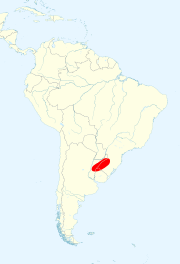Anodorhynchus
| Anodorhynchus | |
|---|---|

| |
| Hyacinth macaw | |
| Scientific classification | |
| Domain: | Eukaryota |
| Kingdom: | Animalia |
| Phylum: | Chordata |
| Class: | Aves |
| Order: | Psittaciformes |
| Family: | Psittacidae |
| Tribe: | Arini |
| Genus: | Anodorhynchus Spix, 1824 |
| Type species | |
| Anodorhynchus maximiliani[1] = Anodorhynchus hyacinthinus von Spix 1824
| |
| Species | |
|
A. glaucus (Vieillot, 1816) | |
Anodorhynchus is a genus of large blue
While blue macaws have been known from taxidermic and captive specimens since at least 1790,[citation needed] location of the Lear's macaw's endemic habitat wasn't known until 1978.[2]
The glaucous macaw was extirpated in the 1800s by clearance for agriculture and cattle grazing of the yatay palm (Butia yatay) groves upon which it fed,[3][4] though rumors of its continued existence persist. Lear's macaws have made a comeback from near extinction in the early 1980s (about 60 birds) to over 1000 as a result of conservation programs. Hyacinth macaws remain locally common within parts of their range, but their range has become fragmented into three known distinct populations in southern Brazil, eastern Bolivia and northeastern Paraguay; populations are declining due to extensive trapping for the pet trade as well as habitat loss.
All Anodorhynchus macaws are listed on CITES Appendix I.
Taxonomy
The genus, Anodorhynchus Spix, 1824
Some recent commentators have suggested that the allopatric Lear's macaw and glaucous macaw should be considered conspecifics.[citation needed]
Besides the three recognised species, there is the
Species details
| Common name | Scientific name and subspecies | Range | Size and ecology | IUCN status and estimated population |
|---|---|---|---|---|
| Glaucous macaw | Anodorhynchus glaucus , 1816)
(Vieillot |
South America (probably extinct) 
|
Size: 70 cm (27.5 in) long, mostly pale turquoise-blue with a large greyish head. It has a long tail and a large bill. It has a yellow, bare eye-ring and half-moon-shaped lappets bordering the mandible.[8] Habitat: Diet: |
CR
|
| Hyacinth macaw or hyacinthine macaw | Anodorhynchus hyacinthinus , 1790)
(Latham |
South America
|
Size: 100 cm (39 in) long, 120-140 cm (48-56 in) wingspan. It is almost entirely blue and has black under the wings. It has a large black beak with bright yellow along the sides of the lower part of the beak and also yellow eyerings.[9] Habitat: Diet: |
VU
|
| Lear's macaw or indigo macaw | Anodorhynchus leari , 1856)
(Bonaparte |
Brazil
|
Size: 70 cm (27.5 in) long, mainly blue and the head is a slightly paler blue. It has bare pale yellow skin at the base of its beak and orange-yellow eyerings. It has a large blackish beak.[10] Habitat: Diet: |
EN
|
See also
- List of macaws
- Spix's macaw, another distantly related blue macaw
References
- ^ "Psittacidae". aviansystematics.org. The Trust for Avian Systematics. Retrieved 2023-07-24.
- ^ Sick, H; Teixeira DM; Gonzaga LP (1979). "Our discovery of the land of the Lear's Macaw (Anodorhynchus leari)". Anais da Academia Brasileira de Ciências (51): 575–576.
- ^ Yamashita, Valle (1993). "On the linkage between Anodorhynchus macaws and palm nuts, and the extinction of Glaucous Macaw. 113". Bulletin of the British Ornithologists' Club. 113: 53–60.
- ^ Begazo, Munn; Castelino, Yamashita (n.d.). "Humans caused the first proven extinction of a South American land bird: a post mortem for the Glaucous Macaw Anodorhynchus glaucus". Draft.
- ^ "Zoological Nomenclature Resource: Psittaciformes (Version 9.004)". www.zoonomen.net. 2008-07-05.
- ^ Donald, Collar; Marsden, Pain (1997). Handbook of the Birds of the World, v4. Barcelona,Spain: Lynx.
- ISBN 0-670-81787-2.
- ^ "Species factsheet: Anodorhynchus glaucus". BirdLife International (2008). Retrieved 24 July 2008.
- ^ "Species factsheet: Anodorhynchus hyacinthinus". BirdLife International (2008). Retrieved 24 July 2008.
- ^ "Species factsheet: Anodorhynchus leari". BirdLife International (2008). Retrieved 24 July 2008.



